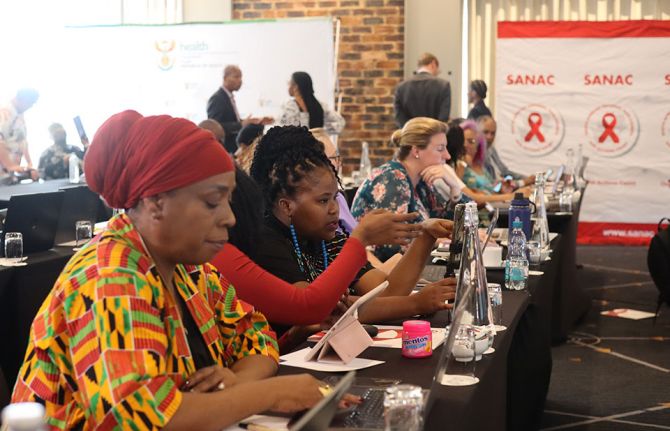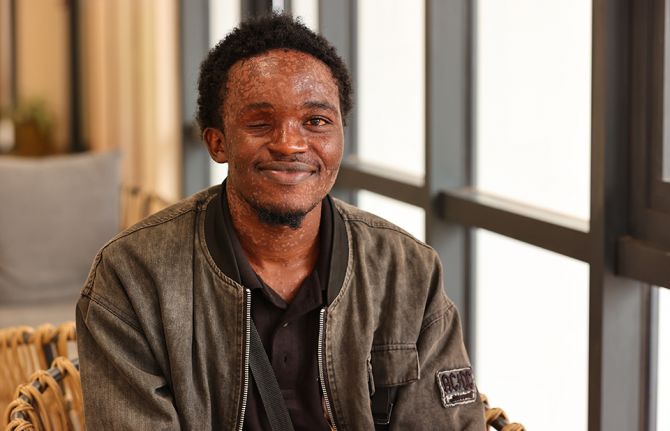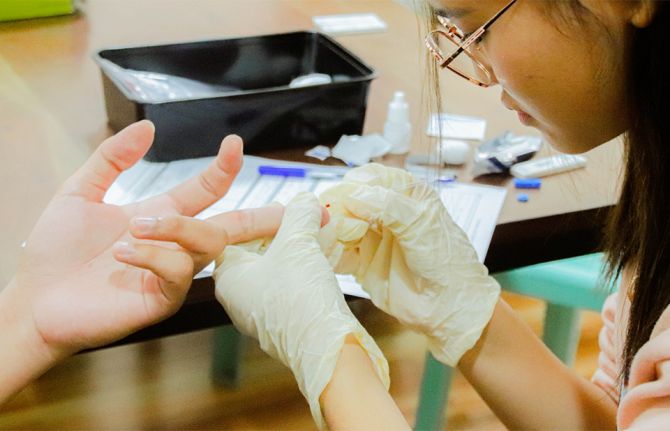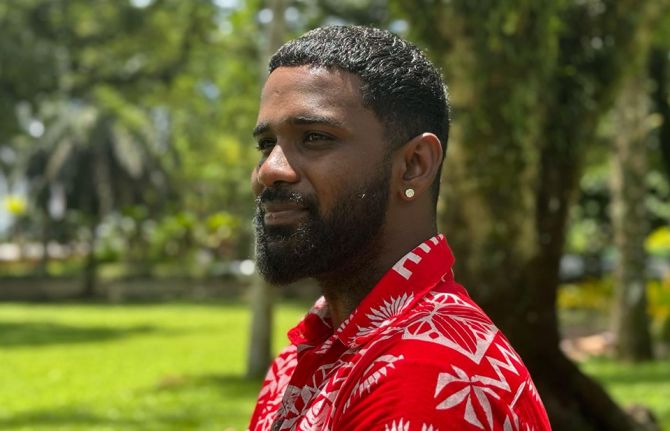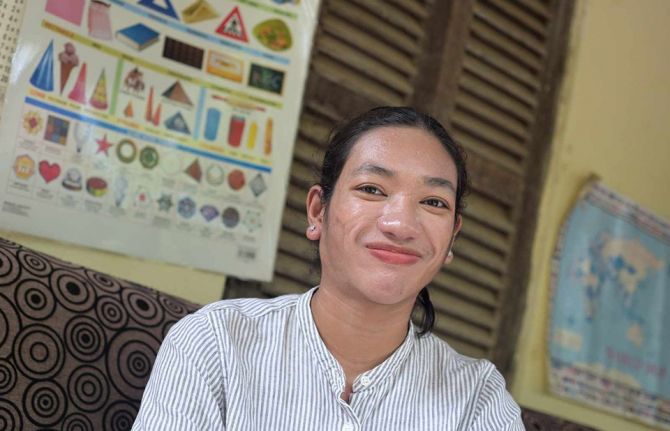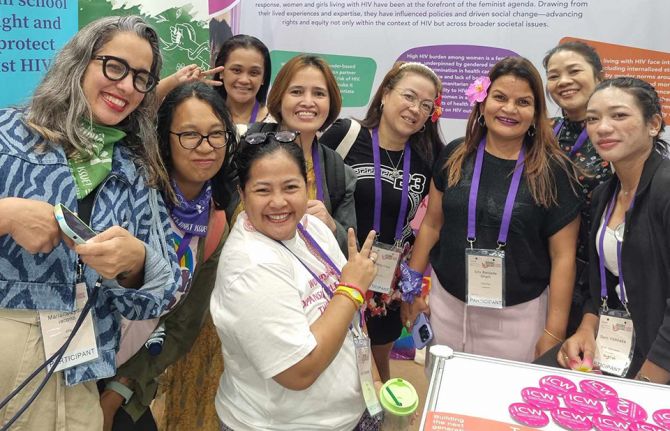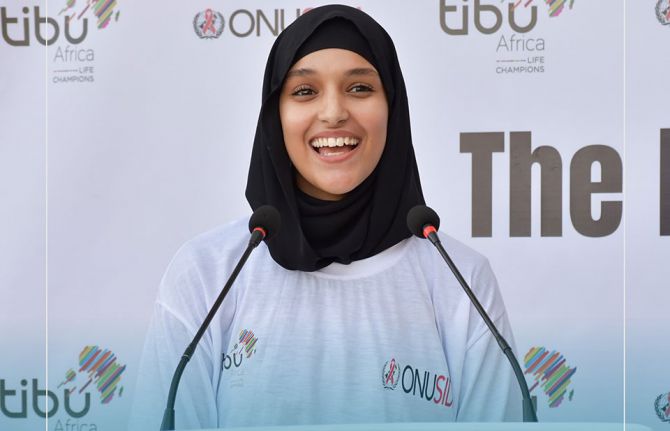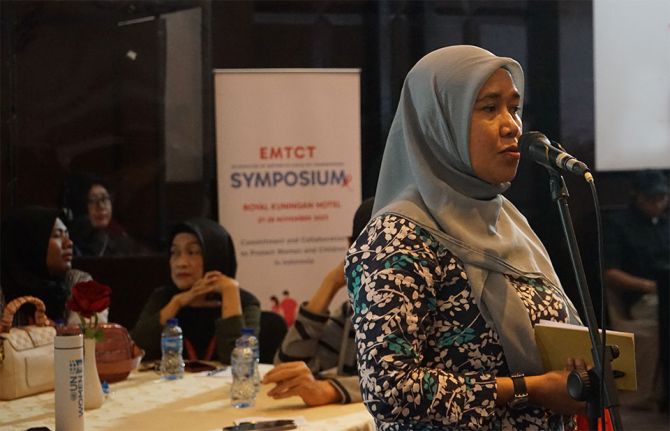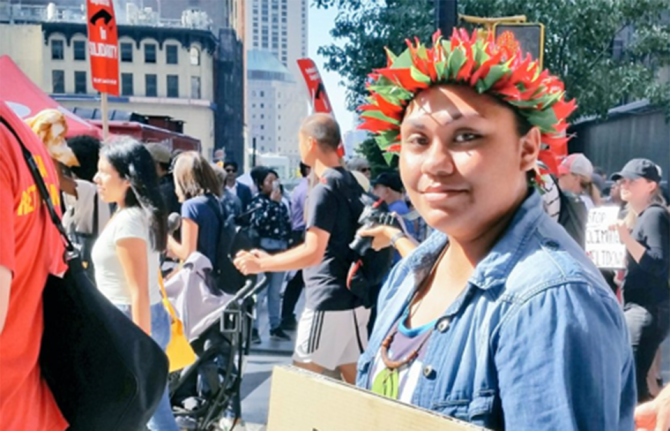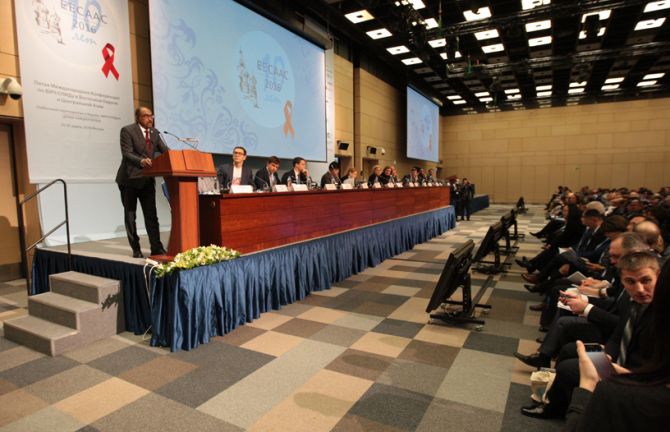
Feature Story
Research project during the World Cup gathers data on sex workers and HIV
12 July 2010
12 July 2010 12 July 2010 The research was supported by a telephone helpline service to respond to health and human rights concerns of sex workers during the World Cup.
The research was supported by a telephone helpline service to respond to health and human rights concerns of sex workers during the World Cup. Credit: UNFPA
As part of the UN South Africa Programme of Support to the FIFA 2010 World Cup, UNFPA and SWEAT (Sex Worker Education & Advocacy Taskforce) partnered with South African researchers to investigate key dimensions of HIV and sex work during the tournament. This rigorous research was supported by a telephone helpline service to respond to health and human rights concerns of sex workers during the World Cup. According to Mr. Eric Harper, Executive Director of SWEAT: “These projects give weight to the rights watch dimension for most-at-risk-populations that is so vital when the largest sporting event in the world occurs.”
Sex work in South Africa became one of the most talked about issues in preparation for the tournament. Newspapers warned of an influx of sex workers to the country to exploit the lucrative potential of the arrival of thousands of soccer fans. As the programme’s lead researcher, Marlise Richter, maintained: “Public health and human rights responses to international sporting events should be based on rigorous, systematic research - not on fear-mongering and sensationalism.” This referred to media reports that over-estimated the number of foreign sex workers headed to the country and the result of confusing issues of trafficking and sex work. The research also addresses the significant data shortages related to sex work and HIV in South Africa in the longer term.
The research assessed sex worker fears, expectations and experiences of the World Cup, gathered information on sex worker mobility, frequency of health care visits and interaction with police. It also tracked the number of clients and potential changes in sex work activity during the World Cup. The tournament presented a strategic opportunity for South Africa to respond to the challenges that the sex industry poses in a rights-based way and provided the momentum for these issues to be taken further in the future. At the same time, conducting research that tracked the changes in the sex work sector during a big, international sporting event is vital to inform future policy and planning for similar events across the world.
Following a right-to-health approach, and in accordance with the UNAIDS Guidance Note on HIV and Sex Work , UNFPA supported SWEAT to provide sexual and reproductive health services, including HIV prevention, to sex workers during the tournament and beyond. Sex workers’ ability to look after their health, more especially their sexual and reproductive health, is inextricably linked to their ability to access human rights in general.
Commenting on the initiative, Dianne Massawe, Project Officer for SWEAT said: “This partnersunhip affords us the opportunity to respond specifically to the sexual and reproductive health aspect through increased outreach and distribution of safer sex tools and information to sex workers. In addition, the telephone helpline provide[d] valuable assistance to sex workers around the human rights abuses they face.”
South Africa is often referred to as the epicentre of the AIDS epidemic, home to the world’s largest number of people living with HIV. Within this epicentre, populations most at risk of HIV infection must be prioritised in prevention strategies. UNFPA supports SWEAT in research that will generate further evidence on the need for comprehensive programmes that promote a human rights-based approach to universal access to HIV prevention, treatment, care and support in the context of adult sex work.
The completed research report is expected by September 2010.
Right Hand Content
Cosponsors:
United Nations Population Fund (UNFPA)
Partners:
Sex Worker Education & Advocacy (SWEAT)
Feature stories:
Swing and Sisters: HIV outreach to sex workers in Thailand (19 March 2009)
Contact:
UNFPA South Africa: Gerit Maritz
maritz@unfpa.org
+27 12 354 8401
Publications:

Feature Story
Helping Vietnamese youth protect themselves against HIV
16 June 2010
16 June 2010 16 June 2010 “This is a unique experience with the UN I’ve never seen elsewhere,” said Lisa Sherburne, an HIV specialist with Save the Children. Credit: UN
“This is a unique experience with the UN I’ve never seen elsewhere,” said Lisa Sherburne, an HIV specialist with Save the Children. Credit: UNPham Xuan Tung talks eagerly and takes notes for his group during a biology lesson on HIV transmission and the replication of the virus in blood cells. This new type of highly interactive class is something Tung, a student at Hoang Quoc Viet upper secondary school in Dong Trieu District, Quang Ninh Province, clearly enjoys.
The class is based on a new, integrated reproductive health and HIV prevention curriculum for secondary school students being developed and piloted by the Ministry of Education and Training (MOET), with support from UNICEF, UNFPA, UNESCO and Save the Children in Viet Nam. Many students in Quang Ninh Province, Quang Tri Province and Ho Chi Minh City are following the new pilot curriculum.
A comprehensive national HIV prevention curriculum

Many students in Quang Ninh Province, Quang Tri Province and Ho Chi Minh City are following the new pilot curriculum. Credit: UN
“I have seen a positive change in the participation of students in my class. The new teaching and learning method allows room for every student to speak up, and they are much more responsive,” said Tung’s teacher Truong Thi Hoa.
The new curriculum for secondary schools nationwide draws on UN-supported work in schools, including healthy living and life skills programmes, reproductive health and HIV prevention initiatives, and pre-service training for teachers. Integrating the areas into core lessons and extra-curricular activities, it includes special training for parents so they can better discuss HIV and reproductive health issues with their children – subjects that can be particularly sensitive and difficult to address.
I have seen a positive change in the participation of students in my class. The new teaching and learning method allows room for every student to speak up, and they are much more responsive.
Truong Thi Hoa, teacher
“This is a unique experience with the UN I’ve never seen elsewhere,” said Lisa Sherburne, an HIV specialist with Save the Children. “It allows more resources, more cohesive actions and a more powerful voice for the Viet Nam education sector.”
The changes are all aimed at integrating HIV prevention into the next national curriculum framework and new textbooks to be developed by the ministry and approved by the National Assembly in 2015.
However, many challenges remain. The ministry needs strong political leadership and greater capacity for planning and coordination, sufficient resources, teachers with better capacity, and effective intra-ministry and multisectoral coordination.
“Our biggest challenge is how to facilitate the close collaboration among departments in the ministry and among ministries related to the education sector response to HIV,” says La Quy Don, vice director of MOET’s Department of Student Affairs.
For Eamonn Murphy, UNAIDS Viet Nam Country Director, this is also a top priority. “We are committed to providing joint support for policy-making, enhanced coordination and implementation of several key aspects of the education sector’s response to HIV.”
Empowering young people to protect themselves against HIV is a key priority area in UNAIDS Outcome Framework 2009-11.
Right Hand Content
Cosponsors:
Partners:
Feature stories:
Sexuality education an imperative for children and young people in a world affected by AIDS (10 December 2009)
UNAIDS Task Team develops effective tools to help young people tackle HIV (05 June 2009)
HIV response and the education sector: UNESCO Best practice series (04 May 2009)
Publications:
A Strategic Approach: HIV & AIDS and Education UNAIDS IATT on Education, 2008 (pdf, 327 Kb.)

Feature Story
UNFPA and CARE announce partnership to improve maternal health
09 June 2010
09 June 2010 09 June 2010A version of this story has been published at unfpa.org
 UNFPA Executive Director Thoraya Obaid (centre) with midwives whose key role in maternal health has been highlighted throughout the Women Deliver conference. Credit: Moises Saman
UNFPA Executive Director Thoraya Obaid (centre) with midwives whose key role in maternal health has been highlighted throughout the Women Deliver conference. Credit: Moises SamanUNFPA, the United Nations Population Fund, and CARE International, one of the world’s largest humanitarian aid agencies, have announced an agreement to enhance collaboration on maternal health programmes in more than 25 countries. This move, launched at the Women Deliver conference in Washington DC, will bring together UNFPA’s effective work with national governments and CARE’s expertise in engaging local communities.
"No woman should die giving life. Through collaboration we can make a bigger impact to improve the health of women and girls. UNFPA partners with governments, other UN agencies and civil society to advance the health and rights of women and girls, and we welcome this new partnership with CARE," said Thoraya Ahmed Obaid, Executive Director of UNFPA, when signing the agreement at the conference in Washington, DC.
No woman should die giving life. Through collaboration we can make a bigger impact to improve the health of women and girls. UNFPA partners with governments, other UN agencies and civil society to advance the health and rights of women and girls, and we welcome this new partnership with CARE.
Thoraya Ahmed Obaid, Executive Director of UNFPA
A key element of promoting maternal health is mounting an effective challenge to HIV as, according to a recent World Health Organization report, AIDS-related illness is the leading cause of death and disease among women of reproductive age in low- and middle-income countries.
Through the Mothers Matter Programme, CARE aims to reduce maternal death by improving access to safe pregnancy and delivery services for 30 million women by 2015. Similar to the work of UNFPA, this signature programme will focus on family planning, skilled attendance at birth and emergency obstetric care within the context of a functioning health system. The Mothers Matter strategy aims to empower communities and civil society organizations to advocate for, and participate in, improved maternal health care; to mobilise local governments and civil society to ensure access to responsive health systems; and to promote supportive policy action while advocating internationally for greater global commitment and investment of resources.
Right Hand Content
Cosponsors:
Feature stories:
Women Deliver conference focuses on MDG 5 (08 June 2010)
Linking maternal and child health to AIDS ahead of G8 Summit (01 June 2010)
Publications:
Adding It Up: The Costs and Benefits of Investing in Family Planning and Maternal and Newborn Health (pdf, 2.10 Mb.)
Women and Health: Today’s Evidence, Tomorrow’s Agenda

Feature Story
President Kabila commits to ensuring an AIDS-free generation in Democratic Republic of Congo
11 May 2010
11 May 2010 11 May 2010 (from left) Thoraya Ahmed Obaid, UNFPA’s Executive Director; President Joseph Kabila of the Democratic Republic of the Congo; and Michel Sidibé, UNAIDS’ Executive Director. 10 May 2010 Credit: UNFPA
(from left) Thoraya Ahmed Obaid, UNFPA’s Executive Director; President Joseph Kabila of the Democratic Republic of the Congo; and Michel Sidibé, UNAIDS’ Executive Director. 10 May 2010 Credit: UNFPAPresident Joseph Kabila of the Democratic Republic of the Congo has pledged to promote the emergence an AIDS-Free Generation, to ensure safer motherhood and to eliminate mother-child-transmission of HIV in his country.
“These are priorities for the women and children of my country,” President Kabila said as he received a joint mission to his nation by Thoraya Ahmed Obaid, UNFPA’s Executive Director, and Michel Sidibé, UNAIDS’ Executive Director.
“I will lead in ensuring an AIDS-Free Generation in DRC,” the President added, expressing his commitment to launch a national initiative to reverse the AIDS epidemic.
The Executive Directors thanked President Kabila for his readiness to make safe motherhood and an AIDS-Free Generation priorities not only in his country, but also in the Southern African Development Community (SADC) and the African Union.
UNFPA’s Ms. Obaid highlighted the links between women’s health, reproductive health and HIV: “By integrating HIV services for maternal and child health with general sexual and reproductive health, the Democratic Republic of the Congo will reap great benefits for the health system.” She urged the country to seize the opportunity offered by the Campaign for the Accelerated Reduction of Maternal Mortality in Africa (CARMMA) to launch the President’s initiative for an AIDS-Free Generation.
Mr. President – you have the unique opportunity to restore the health and dignity of mothers, sisters and daughters in DRC and beyond.
Michel Sidibé, Executive Director of UNAIDS
UNAIDS’ Mr. Sidibé welcomed President Kabila’s decision to use his leadership as Chair of the SADC to rally his peers across Africa to support this urgent agenda. “Mr. President – you have the unique opportunity to restore the health and dignity of mothers, sisters and daughters in DRC and beyond.”
The Executive Directors stressed the need to take AIDS out of isolation and integrate it with related health interventions for the most effective outcomes. They called the virtual elimination of mother-to-child transmission by 2015 a concrete but achievable goal.
Currently, more than 40,000 infants are born with HIV infection every year in the Democratic Republic of the Congo. Only 2 per cent of pregnant women have access to services to prevent mother-to-child transmission, and only 8 per cent of pregnant of women are offered HIV testing and counselling.
The Democratic Republic of the Congo is one of the six countries in the world that together account for 50 per cent of the world’s maternal deaths. Each hour, maternal death takes the lives of about four women.
During their joint mission, the Executive Directors are also scheduled to meet with the Prime Minister, other Government officials, parliamentarians and civil society representatives, including people living with HIV.
President Kabila commits to ensuring an AIDS-free
Cosponsors:

Feature Story
54th Commission on the Status of Women opening calls for Action on Gender Equality
02 March 2010
02 March 2010 02 March 2010A version of this story is published at www.unfpa.org

During a high-level panel on the opening day of the 54th Commission on the Status of Women, UNFPA Executive Director Thoraya A. Obaid, speaking on behalf of the United Nations, called attention to the links between the right to sexual and reproductive health and women's empowerment, gender equality and the achievement of the Millennium Development Goals.
Throughout the first two weeks of March, the 54th Commission on the Status of Women will conduct a 15-year review of the Beijing Declaration and Platform for Action. This Platform, which emerged from the Fourth World Conference on Women in 1995, reinforced the importance of women's rights and empowerment as established a year earlier in Cairo. It called for action on 12 key issues: poverty, education and training, health, violence against women (one of UNAIDS nine priority areas), armed conflict, economy, power and decision-making, institutional mechanisms, human rights, media, environment and girls.
We stand a better chance of solving the world’s problems if men and women join together as equal partners in finding innovative solutions.
UNFPA Executive Director Thoraya A. Obaid
The commission will emphasise the sharing of best practices as well as discussion of obstacles and gaps, especially those related to achieving the Millennium Development Goals, whose tenth year review will take place in September. The synergy among the three development platforms has been articulated by UNFPA Executive Director in a statement she has issued to mark International Women’s Day 2010 (8 March).
“In 1994, at the International Conference on Population and Development (ICPD), leaders declared for the first time that reproductive health and rights are fundamental to women’s empowerment, gender equality and sustainable development. And fifteen years ago, at the Fourth World Conference on Women, world leaders agreed on a platform for action for equality, development and peace.
“Today many of these agreements are reflected in the Millennium Development Goals to which world leaders have agreed, to reduce poverty and put our world on a more sustainable path…With ideas spreading faster than ever, here is an idea whose time has come: We stand a better chance of solving the world’s problems if men and women join together as equal partners in finding innovative solutions.”
At the commission, UNFPA is participating in several side events on sexual and reproductive health rights, HIV, violence against women, peace and security, the role of men and boys as partners for gender equality, and female migration. The Fund is also releasing a review of its contributions to the Beijing commitments, Beijing at Fifteen: UNFPA and Partners Charting the Way Forward (2010).
Another initiative to promote the idea of gender equality and empowerment of women during 2010 is a special radio/audio series on gender equality and the empowerment of women with a focus on young woman and adolescent girls. The programmes, being produced by UN Radio with support from UNFPA, will explore the challenges facing young adolescent girls, as well as their dreams for the future. Additional activities throughout the year will call attention to the Beijing Platform and its links to the International Conference on Population and Development and the Millennium Development Goals
54th Commission on the Status of Women opening ca
Cosponsors:
United Nations Population Fund (UNFPA)
Press centre:
Statement by UNAIDS and UNIFEM to the 54th session of the Commission on the Status of Women (pdf, 63 Kb)
Feature stories:
UNDP Head Helen Clark highlights importance of gender equality for Papua New Guinea to achieve MDGs (22 February 2010)
Linking sexual and reproductive health and rights and HIV prevention is key says Dutch AIDS Ambassador Marijke Wijnroks (08 February 2010)
WHO tool to integrate gender into AIDS programmes (15 January 2010)
Publications:
Agenda for accelerated country action for women, girls, gender equality and HIV (pdf, 676 Kb)
Beijing at 15 UNFPA and Partners Charting the Way Forward
UNAIDS Outcome framework 2009-11 (pdf, 396 Kb.)
Fact sheet: Women, girls and HIV (pdf, 31.6 Kb.)

Feature Story
Sexuality education an imperative for children and young people in a world affected by AIDS
10 December 2009
10 December 2009 10 December 2009
(From L to R) Mark Richmond, UNESCO’s Global Coordinator on HIV and AIDS, Dr Mariangela Batista Galvao Simao, Director, Brazil National STD/AIDS Programme, Michel Sidibé, UNAIDS Executive Director, Elizabeth Mataka, member of the Global Advisory Group on Sexuality Education and the UN Secretary-General’s Special Envoy for AIDS in Africa and Marijke Wijnroks, the AIDS ambassador for the Netherlands
Credit: UNAIDS/D.Bregnard
In many parts of the world, a combination of social taboos, unavailability of sound information, lack of resources and infrastructure make it difficult for children and young people to access sexuality education aimed at improving knowledge and reducing risk. This leaves many young people vulnerable to coercion, abuse, exploitation, unintended pregnancy and sexually transmitted infections, including HIV.
According to the UNAIDS 2008 Global Report on the AIDS Epidemic, only 40% of young people aged 15-24 had accurate knowledge about HIV and transmission. It should come as no surprise that, against this background of insufficient levels of basic knowledge, young people aged 15-24 account for 40% of all new HIV infections (UNAIDS 2009 AIDS Epidemic Update).
In response to this challenge, the voluntary and non-mandatory International Technical Guidance on Sexuality Education developed by UNESCO in partnership with UNAIDS, UNFPA, UNICEF and WHO seeks to assist education, health and other relevant authorities to develop and implement school-based sexuality education materials and programmes. The International Technical Guidance on Sexuality Education is based on a rigorous review of evidence on sexuality education programmes and is aimed at education and health sector decision-makers and professionals.
If we are to make an impact on children and young people before they become sexually active, comprehensive sexuality education must become part of the formal school curriculum, delivered by well trained and supported teachers.
Michel Sidibé, UNIADS Executive Director
Sexuality education can play a key role in improving knowledge and reducing sexual risk behaviours among young people. Equipped with better knowledge, information and skills, young people can be empowered to make informed decisions about sexual choices.
“If we are to make an impact on children and young people before they become sexually active, comprehensive sexuality education must become part of the formal school curriculum, delivered by well trained and supported teachers,” says Michel Sidibé, UNAIDS Executive Director. “Teachers remain trusted sources of knowledge and skills in all education systems and they are a highly valued resource in the education sector response to AIDS.”
The International Technical Guidance on Sexuality Education was co-authored by leading experts in the field of sexuality education and subjected to extensive review and comment by a global panel of experts and practitioners from civil society organizations, ministries of education and international agencies. Volume I of the International Technical Guidance on Sexuality Education focuses on the rationale for sexuality education and provides sound technical advice on characteristics of effective programmes. It is the outcome of a rigorous review of the literature on the impact of sexuality education and sexual behaviour, drawing upon 87 studies from around the world.
Numerous studies show that with the right information and skills, young people can change their behaviour to reduce the risk of acquiring HIV infection or passing it on to others.
Mark Richmond, UNESCO’s Global Coordinator on HIV and AIDS
A companion document (Volume II) focuses on the topics and learning objectives to be covered in a ‘basic minimum package’ on sexuality education for children and young people from 5 to 18+ years of age and includes a bibliography of useful resources. It was informed by a review of curricula from 12 countries, as well as other international models.
“Numerous studies show that with the right information and skills, young people can change their behaviour to reduce the risk of acquiring HIV infection or passing it on to others,” says Mark Richmond, UNESCO’s Global Coordinator on HIV and AIDS and the Director for the Division for the Coordination of UN Priorities in Education. “At a minimum, HIV and AIDS education needs to include information on the HIV virus and its modes of transmission. At some point, HIV and AIDS education must introduce sex and relationships education - simply because over 75% of all HIV infections occur through sexual transmission.”
The UN organizations called on policy-makers to listen to young people, families, teachers and other practitioners, and use the International Technical Guidance to make sexuality education an integral part of the national response to the HIV pandemic.
UNESCO and its partners including UNAIDS, UNFPA, UNICEF and WHO, as well as a wide range of other partners, will support governments in operationalising the International Technical Guidance on Sexuality Education at regional and country level. The two volumes of the International Technical Guidance will be published in all the six UN languages (Arabic, Chinese, English, French, Russian and Spanish) as well as Portuguese.
Sexuality education an imperative for children an
Key populations:
Cosponsors:
Feature stories:
Michel Sidibé calls for prevention revolution in opening address at UNAIDS’ governing body meeting (08 December 2009)
Preventing HIV through education in Latin America and Caribbean (31 July 2009)
New publication champions a strategic approach to HIV and education (15 June 2009)
Publications:
International Technical Guidance on Sexuality Education (Volume-I) (pdf, 2.84 Mb.)
International Technical Guidance on Sexuality Education (Volume-II) (pdf, 1.94 Mb.)

Feature Story
World AIDS Day to be marked by UNAIDS Office in Washington
30 November 2009
30 November 2009 30 November 2009In collaboration with twenty-six civil society organizations, the United Nations Development Programme (UNDP), the United Nations Office on Drugs and Crime (UNODC), the United Nations Population Fund (UNFPA), and the World Bank, UNAIDS is hosting a luncheon on 1 December which completes a policy forum series on HIV, human rights and key at-risk populations.
In recent months UNAIDS has hosted leaders from around the world in Washington, DC to discuss the human rights issues of addressing HIV in three key at-risk populations: men who have sex with men on 16 September; sex workers on 15 October; and people who inject drugs on 12 November. A representative from each population will address human rights and universal access. Civil society representatives will present recommendations to the United States government. U.S. Representative Jim McDermott (Washington State) will give special remarks.
Related
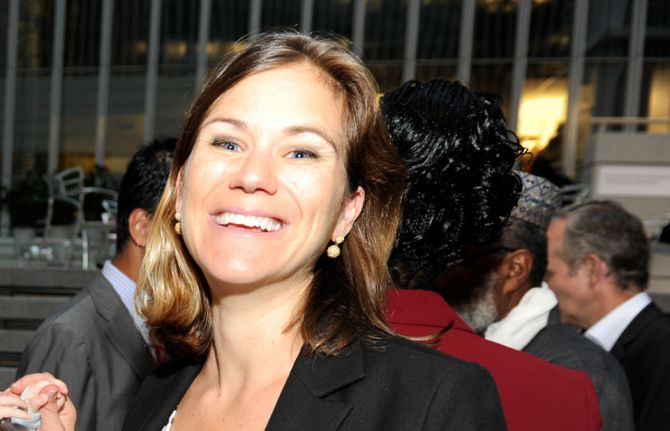 A tribute to Maeve Kennedy Townsend McKean
A tribute to Maeve Kennedy Townsend McKean

09 April 2020
 UNAIDS is awarded the Science and Medicine Award at the 25th Annual Steve Chase Awards
UNAIDS is awarded the Science and Medicine Award at the 25th Annual Steve Chase Awards

12 February 2019
 AIDS care in the Californian desert
AIDS care in the Californian desert
12 February 2019

Feature Story
UNFPA report: Exploring links between HIV and climate change
18 November 2009
18 November 2009 18 November 2009
State of the Worlds Population, 2009
Credit: UNFPA
The success of the global response to AIDS will rely on tackling not only the encroaching virus itself but also the affects of climate change such as food and water shortages, growth in poverty and an increase in natural disasters, argues the State of World Population 2009, released today by the United Nations Population Fund (UNFPA).
The report also contends that, equally, strengthening the response to the AIDS epidemic will mean that individuals, communities and societies will have greater social resilience in the face of a range of climate change threats and will be better able to deal with their consequences. HIV and climate change are perceived as profoundly linked, a perception shared by a range of UN bodies, including UNAIDS and the United Nations Environment Programme, UNEP.
Subtitled, ‘Facing a changing world: women population and climate’, The State of World Population places women at the very centre of the attempt to confront climate change and maintains that policies, programmes and interventions are more likely to mitigate its worst effects if they reflect the rights and needs of women.
Poor women in poor countries are among the hardest hit by climate change, even though they contributed the least to it.
UNFPA Executive Director Thoraya Ahmed Obaid
Women are said to bear the brunt of climate change, partly because in many countries they make up the majority of the agricultural workforce hard hit in an environmental crisis, and because they often do not have sufficient control of their lives and access to as many opportunities to generate income as men – they are more likely to be poor and to see their poverty increase. As UNFPA Executive Director Thoraya Ahmed Obaid has it, “Poor women in poor countries are among the hardest hit by climate change, even though they contributed the least to it.”
Numerous examples of extreme climate change are cited, from melting glaciers in Bolivia, to the destruction of crops by typhoons in the Philippines, and from drought in east and southern Africa to floods in Vietnam. In each scenario, women are shown struggling to keep their livelihoods and families intact, and, in some cases, fighting for their lives.
According to the report, empowering women and girls, especially through investments in health and education, help boost economic development and reduce poverty, thus having a beneficial impact on coping with climate change. Girls with more education are more likely to protect themselves against HIV and to have smaller and healthier families as adults. In general, access to reproductive health services such as family planning means lower fertility rates and this has a clear bearing on lessening the potential impact of environmental crises and making sustainable development more likely.
“Women should be part of any agreement on climate change—not as an afterthought or because it’s politically correct, but because it’s the right thing to do,” says Ms Obaid. “Our future as humanity depends on unleashing the full potential of all human beings, and the full capacity of women, to bring about change.”
The State of World Population 2009 argues that ensuring gender inequity is challenged in all its facets is an urgent necessity, not just to improve the lives of individual women but to stave off the worst consequences of environmental crisis. This sense of urgency is relayed to the leaders and negotiators due to meet in Copenhagen for December’s critical climate change conference. They are urged to “think creatively” not just about emissions and targets but about population, reproductive health and gender equality and how they can contribute to “a just and environmentally sustainable world.”
UNFPA report: Exploring links between HIV and cli
Cosponsors:
UNFPA
WHO: HIV
WHO: Gender, Women and Health
Partners:
UN Worldwide Campaign on Climate Change
The Global Coalition on Women and AIDS (GCWA)
Feature stories:
Food by Prescription: A Landscape paper from GAIN (16 November 2009)
Violence against women and HIV (10 November 2009)
WHO report on the health of women: AIDS leading cause of death globally in women of reproductive age (09 November 2009)
Examining links between AIDS and climate change (07 July 2009)
Publications:
The State of World Population 2009 ( fr | ru | ar )
State of World Population 2009: Youth supplement ( fr | ru | ar )
Women and Health: Today’s Evidence, Tomorrow’s Agenda

Feature Story
Empowering women to protect themselves: Promoting the female condom in Zimbabwe
29 October 2009
29 October 2009 29 October 2009Langton Ziromba promotes female condoms in the casual and friendly space of his barber shop
Courtesy of UNFPA
When AIDS first emerged in the 1980s, it mainly affected men. Today, according to UNAIDS figures, women account for about half of the 33 million people living with HIV worldwide, and 60 per cent of those infected in sub-Saharan Africa. Most of these women acquired the virus through heterosexual intercourse, often through unprotected sex with their husbands or long-term primary partners.
“Women think marriage is a safe haven,” says Beauty Nyamwanza of Zimbabwe’s National AIDS Council. “They think that when you’re married, you don’t have to worry about HIV.”
But what the AIDS-prevention team in the country found out is that marriage can actually increase the risk of HIV among young women. According to research carried out in Kenya and Zambia in 2004 , marriage increases the frequency of sex and hinders a woman’s ability to negotiate condom use or abstain from sex. Married women are often afraid to ask their husbands to use a condom – or to use one themselves – since this implies that they suspect their husbands of infidelity.
Women think marriage is a safe haven. They think that when you’re married, you don’t have to worry about HIV.
Beauty Nyamwanza of Zimbabwe’s National AIDS Council
Thanks to the efforts of Ms Nyamwanza and others, Zimbabwe is one of a handful of countries that has taken advantage of the female condom and made major inroads in promoting its use. The latest device, the FC2, is a strong, flexible, nitrile sheath, about 17 centimetres (6.7 inches) long, with a flexible ring at each end. The closed end is inserted into the woman’s body, and the open end remains outside during intercourse. Like the male condom, it offers dual protection against unintended pregnancy and sexually transmitted infections, including HIV. But it has one critical advantage: it is the only available technology for HIV prevention that women can initiate and control.
Condom promoters in Zimbabwe suggest that married women can present the female condom as a means of child spacing. In this way, the issue of a woman appearing to accuse her husband of having other partners and putting her at risk need not arise.
Building support
Zimbabwe introduced the female condom in 1997, but acceptance was slow. Eventually, the Government requested support from the United Nations Population Fund (UNFPA) to scale up promotion of both male and female condoms through the public sector. Beyond training condom promoters, highly creative ways to educate the public about condom use were employed. Billboards, radio spots and TV commercials helped break down taboos against talking about condoms, and thus helped overcome the stigma sometimes associated with them. In the process of implementing the strategy, the team – which included the Ministry of Health and Child Welfare, the Zimbabwe National Family Planning Council, the National AIDS Council and Population Services International (PSI) – discovered that the female condom can be a tool for empowerment, enabling women and adolescent girls to take the initiative in protecting their own reproductive health and that of their partners.
From 2005, when the strategy was launched, to 2008, female condom distribution by the public sector in Zimbabwe increased five-fold, from about 400,000 to more than two million. Sales of female condoms through social marketing rose from some 900,000 to more than 3 million, and sales of male condoms also increased.
Involving men
One person who has seen the change coming is Langton Ziromba. He owns a small, outdoor barbershop in the Budirio section of Harare. In addition to haircuts, shaves and chats about football and women, Mr Ziromba provides another service to his male customers: information about female condoms, how they are used, and the advantages to both partners. He is one of about 70 barbers and 2,000 hairdressers in Zimbabwe who have been trained to promote the female condom. He sells Zimbabwe’s most popular brand, called Care, and makes a small commission on the highly subsidised price.
This poster is part of a major advertising campaign promoting condoms in Zimbabwe
Photo: PSI Zimbabwe
“Our research shows that for this product to be accepted and used by women, we also need to involve men,” says Margaret Butau of the National Family Planning Council. “We customise the benefits of the female condom according to the target group we are addressing.” Specific points highlighted for men include the fact that the female condom is not constricting like the male condom, it is even less prone to breakage, its use does not require an erection and it can enhance pleasure for both partners. Moreover, it is not necessary to withdraw immediately after ejaculation. And, finally, it could be seen as the woman’s responsibility. “When we point all this out, we find that men become curious about having their partners try the product.”
Providing a model for other countries
The Zimbabwe campaign created by PSI that uses hairdressers to market condoms has served as a model for a similar programme in Malawi. Some 2,400 Malawian hairdressers now sell, and serve as advocates for, the female condom in the country. Their numbers are growing as word spreads. Sandra Mapemba, a national programme officer in the UNFPA office in Malawi, says the impact has been dramatic. “The female condom is actually empowering women to become more assertive and to stand up for their own health issues,” she says. “That’s the most exciting thing for me. Women who are in discordant relationships or women who are HIV-positive come and tell me that now they can actually insist on condom use. Before, their partners would refuse.”
The response has been so positive that UNFPA Malawi is now providing training in condom programming to some 35 international and local NGOs working on HIV-prevention in the country. Over the course of three years, female condom distribution through the public sector alone in Malawi increased from 124,000 in 2004-2005 to nearly a million in 2008.
Programming challenges persist
The success of UNFPA and its partners in promoting the female condom in Zimbabwe, Malawi and also in Zambia has prompted other countries to seek similar assistance. Though global distribution of female condoms nearly tripled from 2004 to 2008 – to a total of 33 million in 90 countries – they still represent only 0.2 per cent of condom use worldwide. Key barriers are cost and availability. Not only are female condoms more expensive than male condoms – they cost as much as $1 per unit in some countries – they are still far less widely available. Through an initiative called comprehensive condom programming, UNFPA is helping countries address these and other issues. The programme is also a platform from which other female-initiated prevention technologies still in development, including cervical caps and microbicides, will be launched.
“Giving women the power to protect themselves could turn the tide of the AIDS epidemic,” says Bidia Deperthes, who leads the comprehensive condom programming initiative for UNFPA. “But we still have a long way to go.” The largest obstacle, in her view, is funding for programming. While the majority of donors willingly contribute essential commodities, including male and female condoms, little money is allocated to laying the groundwork needed to create awareness and demand, and to train women to use condoms correctly and consistently. “It’s all part of one comprehensive package.”
This article was adapted from an upcoming UNFPA publication “Prevention Gains Momentum: Successes in female condom programming”.
Empowering women to protect themselves: Promoting
Cosponsors:
United Nations Population Fund (UNFPA)
Partners:
Population Services International (PSI)
The Global Coalition on Women and AIDS
Feature stories:
Barber Shops and Beauty Salons promote HIV education in Guyana (26 March 2009)
Commission on the Status of Women opens with call for action to achieve universal access and gender equality (02 March 2009)
ICASA 2008: Addressing the vulnerability of young women and girls to HIV in southern Africa (03 December 2008)
Publications:
UNAIDS Technical Meeting on Young Women in HIV Hyper-endemic countries of Southern Africa (pdf, 11.3 Mb.)
2008 Delegates Guide to Women and AIDS: All Women, All Rights (pdf, 506 Kb.)

Feature Story
Y-PEER in Lebanon: Youth leadership in action
29 September 2009
29 September 2009 29 September 2009
With arts and culture being pillars of the Jeux de la Francophonie, the Y-PEER network performed a dance and song written by its members about AIDS. Beirut, 28 September 2009. Credit: UNAIDS/Nabil
The UNFPA-supported Y-PEER initiative is a groundbreaking youth programme that raises HIV prevention awareness through street art, music and dance. UNAIDS Executive Director Michel Sidibé had the opportunity this week to attend a dance performance by the Youth Peer Education Network during the Jeux de la Francophonie.
With arts and culture being one of the two pillars of the Jeux de la Francophonie, the Y-PEER network performed a dance and song written specifically by its members for these games. The lyrics include HIV prevention messages in Arabic, French and English, with the dancers forming a large red ribbon of red fabric at the end of the routine.
UNAIDS and our Cosponsors are committed to including young people’s leadership as an integral part of national responses including empowering young people to prevent sexual and other transmission of HIV infection among their peers.
Culture and creative expression are powerful tools for mobilizing people of all ages and I applaud the Y-PEER.
Michel Sidibé, UNAIDS Executive Director
“UNAIDS and our Cosponsors are committed to including young people’s leadership as an integral part of national responses including empowering young people to prevent sexual and other transmission of HIV infection among their peers,” said Mr Sidibé.
“This evening’s performance was inspiring, putting these goals into action with young people creatively participating in the AIDS response in their own terms,” said Mr Sidibé after the show. “Culture and creative expression are powerful tools for mobilizing people of all ages and I applaud the Y-PEER.”
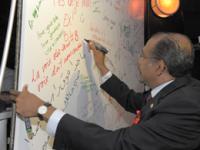
UNAIDS Executive Director Michel Sidibé writes a message at the UNAIDS booth at Y-PEER event, Beirut, 28 September 2009. Credit: UNAIDS/Nabil
Y-PEER is a groundbreaking and comprehensive youth-to-youth initiative pioneered by UNFPA. The international network includes over 7000 young peer educators in Europe, Central Asia, Latin America, North Africa and the Middle East. The network has adopted an approach of “edutainment”—combining education and entertainment— to communicating HIV facts. Young people work together to raise awareness on sexual and reproductive health including the facts about sexually transmitted infection and HIV prevention.
The Lebanese Y-PEER network was launched in 2008 with the support of UNFPA and through 35 peer educators, the network has reached 1000 young people all over country in just three months.
With 7,400 new HIV infections daily worldwide and young people aged 15-24 accounting for 45% of these.
The Jeux de la Francophonie brings together sport and culture to foster dialogue and understanding among French speaking nations. It will run in Beirut until 6 October, bringing together 70 countries from all over the world.
Y-PEER in Lebanon: Youth leadership in action
Cosponsors:
Partners:
Feature stories:
Jeux de la Francophonie and UNAIDS: Partnering for young people (28 September 2009)
Publications:
Joint action for results: UNAIDS outcome framework, 2009 – 2011 (pdf, 388 Kb.)
Sexual and reproductive health and HIV - Linkages: Evidence review and recommendations (pdf, 786 kb.)
Preventing HIV/AIDS in young People: A systematic review of the evidence from developing countries UNAIDS Inter-agency Task Team on Young People (Report | 8 pages summary | 4 pages summary)
Related
 “Who will protect our young people?”
“Who will protect our young people?”

02 June 2025

